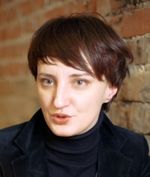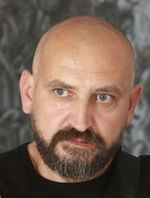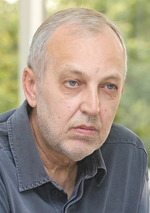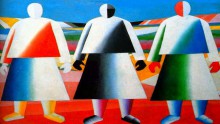The outstanding avant-garde artist Kazimir Malevich was born in Kyiv in 1878. He lived with his parents until the age of 17 in the villages and towns of the Podillia, Kharkiv and Chernihiv regions. He returned to Kyiv from Russia in 1927 and taught at the Kyiv Art Institute. Malevich knew and loved the Ukrainian language, folk art, and songs. His oeuvre also included the Holodomor theme. Like many other Ukrainian culture figures, Malevich fall victim to Stalinism. After all, he often called himself Ukrainian. However, in spite of all this, he is a Russian artist for the world. For the time being…
Kyiv hosted the other day a roundtable, “Malevich: Ukrainian Dimension and Global Perspective,” as part of the Malevich Days. Experts, artists, and academics were trying not only to clarify why Malevich’s Ukrainian identity had been forgotten, but also to find ways to bring him back into his native context and, what is more, to map out a common strategy towards the layers of Ukrainian culture, which were misappropriated by imperial ideologues.
One of the first and foremost steps, which all the forum participants approved of, is to name Boryspil airport after Kazimir Malevich. In particular, one of those who resolutely supported this proposal is Kyiv Deputy Mayor Oleksii Reznikov, cochairman of the renaming commission. Incidentally, Ukraine’s Infrastructure Minister Volodymyr Omelian said this question would be soon put on an open vote in the Internet.

AS PART OF THE MALEVICH DAYS, KYIV’S MYSTETSKY ARSENAL STAGED THE “MALEVICH+” ART PROJECT. THE EXHIBITION WILL LAST UNTIL AUGUST 7 / Photo by Artem SLIPACHUK, The Day
The event, held at Kyiv Mohyla Academy’s Business School, was moderated by its Dean Oleksandr Savruk.
DMYTRO HORBACHOV: “UKRAINIAN IDENTITY IS THE KEY POSITION OF THE ARTIST HIMSELF”
 Art historian Dmytro Horbachov recalls the exhibition of Ukrainian avant-garde in Germany in 1993, when there were some Russians among the organizers. “Contempt for Ukrainian culture was discernible even there,” the expert says. “They insisted that the exhibition be called ‘Avant-garde and Ukraine’ because the very idea of ‘Ukrainian avant-garde’ provoked uproarious laughter among them – avant-garde cannot be Ukrainian, you see. Yet German journalists ignored this and wrote precisely about ‘Ukrainian avant-garde.’ Next year the Germans published a fundamental reference book, 20th-Century Artists. It is written there that Malevich was ‘a Ukrainian painter and sculptor, an outstanding figure of Russian culture.’ Accordingly, Picasso was referred to as ‘a Spanish artist, a figure of French culture.’ This approach was supposed to satisfy everybody, but the Russians are a specific nation. When we published the book Malevich and Ukraine (Kyiv, 2006), a Russian art critic I knew was surprised. ‘Malevich’s Ukrainianness is confined to the phrase ‘born in Kyiv,’ so how could you drag it on for 492 pages?’ she said. By the way, Malevich himself wrote in questionnaires that he was Ukrainian. His sister told me she had been arguing with him over this, for she considered herself Polish. Indeed, Malevich’s father was Seweryn Malewicz, a Pole, and his mother was Ludwika Halynowska, a Polonized ethnic Ukrainian. It follows from the Malevich family tree, which art historian Serhii Papeta found, that the 17th-century Malewiczes were Volhynia nobles and there were Roman Catholic, Greek Catholic, and Orthodox priests among the artist’s ancestors – a situation typical of Ukraine.”
Art historian Dmytro Horbachov recalls the exhibition of Ukrainian avant-garde in Germany in 1993, when there were some Russians among the organizers. “Contempt for Ukrainian culture was discernible even there,” the expert says. “They insisted that the exhibition be called ‘Avant-garde and Ukraine’ because the very idea of ‘Ukrainian avant-garde’ provoked uproarious laughter among them – avant-garde cannot be Ukrainian, you see. Yet German journalists ignored this and wrote precisely about ‘Ukrainian avant-garde.’ Next year the Germans published a fundamental reference book, 20th-Century Artists. It is written there that Malevich was ‘a Ukrainian painter and sculptor, an outstanding figure of Russian culture.’ Accordingly, Picasso was referred to as ‘a Spanish artist, a figure of French culture.’ This approach was supposed to satisfy everybody, but the Russians are a specific nation. When we published the book Malevich and Ukraine (Kyiv, 2006), a Russian art critic I knew was surprised. ‘Malevich’s Ukrainianness is confined to the phrase ‘born in Kyiv,’ so how could you drag it on for 492 pages?’ she said. By the way, Malevich himself wrote in questionnaires that he was Ukrainian. His sister told me she had been arguing with him over this, for she considered herself Polish. Indeed, Malevich’s father was Seweryn Malewicz, a Pole, and his mother was Ludwika Halynowska, a Polonized ethnic Ukrainian. It follows from the Malevich family tree, which art historian Serhii Papeta found, that the 17th-century Malewiczes were Volhynia nobles and there were Roman Catholic, Greek Catholic, and Orthodox priests among the artist’s ancestors – a situation typical of Ukraine.”
According to Horbachov, recognition of his Ukrainian identity was a crucial point for Malevich who did not even know the Russian language before he turned 17. “Later, when the artist switched to Russian, he went on ‘spicing up’ his speech with Ukrainian phrases and sayings,” the expert says. “Even Russian art historians admit this, albeit interpreting it as… a Belarusian accent.”
At the same time, Horbachov notes that everybody seems to accept at least one point: Malevich is the world’s best known Kyivite.
OLHA ZHUK: l “MALEVICH IS ONE OF THE INDIVIDUALS WHO HAVE PROJECTED THE IMAGE OF UKRAINE IN THE WORLD”
 In the view of Olha Zhuk, in charge of cultural diplomacy at the Ministry of Foreign Affairs, Kazimir Malevich is one of the individuals who have projected the image of Ukraine in the world. “Embedding into the worldwide context of art history is a very important process. If the name of Malevich begins to be associated with Ukraine, at the academic level, this will also have institutional consequences. Take, for example, museums. Whenever a new exhibit of avant-gardism is held abroad, there should be a Ukrainian context there instead of the customary caption ‘Russian artist.’ This is what the job of cultural diplomacy is about. The world has a considerable experience of countries promoting their names. What is ‘canonical’ from this angle is the US State Department-sponsored program ‘Art in Embassies.’ Ukraine also has a possibility, but lacks competence, to show art at embassies. The goal of cultural diplomats is to establish a tie between experts’ communities, art institutions, and diplomatic missions abroad.”
In the view of Olha Zhuk, in charge of cultural diplomacy at the Ministry of Foreign Affairs, Kazimir Malevich is one of the individuals who have projected the image of Ukraine in the world. “Embedding into the worldwide context of art history is a very important process. If the name of Malevich begins to be associated with Ukraine, at the academic level, this will also have institutional consequences. Take, for example, museums. Whenever a new exhibit of avant-gardism is held abroad, there should be a Ukrainian context there instead of the customary caption ‘Russian artist.’ This is what the job of cultural diplomacy is about. The world has a considerable experience of countries promoting their names. What is ‘canonical’ from this angle is the US State Department-sponsored program ‘Art in Embassies.’ Ukraine also has a possibility, but lacks competence, to show art at embassies. The goal of cultural diplomats is to establish a tie between experts’ communities, art institutions, and diplomatic missions abroad.”
Ms. Zhuk also singled out the Educatorium culture laboratory’s project “Avant-garde Embroidery” which puts emphasis on the links between Malevich’s works and decorative folk art and fits in very well with the contemporary trend of culture industries and design. The project is based on the sketches of embroidered shirts made by Malevich and a group of avant-gardists at the village of Verbivka in the early 20th century. Present-day Ukrainian masters have done this embroidery on the basis of these sketches. The project is to be presented at the Ukrainian Embassy in Amsterdam in the autumn.
OLESIA DRASHKABA: “THE FIRST REPRESSIONS IN THE 1930s WERE AIMED AGAINST ART HISTORIANS”
 Olesia Drashkaba, artist and creative director of the Publicis Visage agency, emphasized that the first purges in the 1930s were aimed against art historians. “This large-scale anti-Ukrainian campaign was launched in the USSR,” the artist says. “The result is that we can still come across Ukrainian art critics today, who argue that Malevich was a Russian avant-gardist. We must tell about Ukrainian avant-gardists abroad, but, above all, we should contribute to the comprehension of this cultural stratum inside Ukrainian society itself. A hundred years ago, Ukraine was an absolutely European country in terms of culture, which saw the development of a powerful urbanistic culture that remained, at the same time, linked to folk art. But then there was a cultural annexation which is still going on. Vienna’s museum Albertina recently hosted a huge exhibition, ‘Russian Avant-garde: from Chagall to Malevich’ – there was not even a hint of ‘born in Kyiv.’ This cultural aggression will last until we become aware of this fact.”
Olesia Drashkaba, artist and creative director of the Publicis Visage agency, emphasized that the first purges in the 1930s were aimed against art historians. “This large-scale anti-Ukrainian campaign was launched in the USSR,” the artist says. “The result is that we can still come across Ukrainian art critics today, who argue that Malevich was a Russian avant-gardist. We must tell about Ukrainian avant-gardists abroad, but, above all, we should contribute to the comprehension of this cultural stratum inside Ukrainian society itself. A hundred years ago, Ukraine was an absolutely European country in terms of culture, which saw the development of a powerful urbanistic culture that remained, at the same time, linked to folk art. But then there was a cultural annexation which is still going on. Vienna’s museum Albertina recently hosted a huge exhibition, ‘Russian Avant-garde: from Chagall to Malevich’ – there was not even a hint of ‘born in Kyiv.’ This cultural aggression will last until we become aware of this fact.”
MYKOLA MATSENKO: l “BLACK SQUARE CONTINUES TO PROVOKE EVEN TODAY”
 Artist Mykola Matsenko launched a Malevich promotion campaign in Ukraine as long as 10 years ago.
Artist Mykola Matsenko launched a Malevich promotion campaign in Ukraine as long as 10 years ago.
He called it “A Square to Every House!” He spins off “black squares” and sells them at a token price in the “crowded” places – from the food marketplace in a district center to Mystetsky Arsenal.
“There are only two pictures known all over the world: La Gioconda by da Vinci and Black Square by Malevich,” Matsenko says. “I saw this when I was mingling with people during my campaign. Black Square continues to provoke debates today, a hundred years on. As for Malevich’s ethnic identity, my friend and coauthor, artist Oleh Tistol, has offered what I think is the best formulation – an ethnic Pole whom Ukraine gave birth to and Russia killed.”
ELENA ORANSKAIA: “RUSSIA INVESTS FANTASTIC SUMS OF MONEY IN PROMOTING ITS ART”
 According to Dutch Art-East+Art-West foundation director Elena Oranskaia, who reached us on Skype, avant-garde is considered an important page of art history in Europe, particularly in the Netherlands. “There are major annual exhibits that attract a lot of spectators,” the expert says. “Yet Ukrainian avant-garde is usually interpreted here as Russian. One of Amsterdam’s leading museums has hosted a large exhibit about Malevich, but the artist’s Kyiv period was not presented. Dutch museums maintain very close ties with Russia. Russia invests fantastic sums of money in promoting its art. All the art historians who deal with avant-garde always pursue advanced studies in Moscow or Saint Petersburg. Accordingly, the Ukrainian avant-garde situation is rather difficult here, but it is changing – even some of the experts who cooperate with the Russians are beginning to use this term. Articles on Ukrainian avant-garde are being published.”
According to Dutch Art-East+Art-West foundation director Elena Oranskaia, who reached us on Skype, avant-garde is considered an important page of art history in Europe, particularly in the Netherlands. “There are major annual exhibits that attract a lot of spectators,” the expert says. “Yet Ukrainian avant-garde is usually interpreted here as Russian. One of Amsterdam’s leading museums has hosted a large exhibit about Malevich, but the artist’s Kyiv period was not presented. Dutch museums maintain very close ties with Russia. Russia invests fantastic sums of money in promoting its art. All the art historians who deal with avant-garde always pursue advanced studies in Moscow or Saint Petersburg. Accordingly, the Ukrainian avant-garde situation is rather difficult here, but it is changing – even some of the experts who cooperate with the Russians are beginning to use this term. Articles on Ukrainian avant-garde are being published.”
YURII MAKAROV: “UKRAINE IS A PERMANENT ‘STORAGE TANK’ OF AVANT-GARDISM”
 On his part, journalist and documentarian Yurii Makarov suggests that Ukraine be considered a “permanent storage tank of avant-gardism.” To prove this assumption, he cites the example of not only Kazimir Malevich, but also… Taras Shevchenko. “When I was researching the figure whom the Ukrainians had spontaneously chosen as their cultural hero, I gained an impression that he was not in reality the bearer of a conservative and populist culture (in fact invented at the turn of the 20th century), within the framework of which he had been viewed before, particularly, in the Soviet era,” Makarov says. “In reality, Shevchenko was an avant-garde figure which was breaking stereotypes. He was a simultaneous bearer of two esthetics – one of Ukrainian baroque and one of Ukrainian romanticism in their most spirited manifestations. This modern avant-garde trend was amply expressed in Ukrainian culture as a whole. If Ukrainians had chosen not Shevchenko but, say, Skovoroda as their cultural hero, Ukrainian culture would have been different. Likewise, the British chose Shakespeare as a role model in the 19th century. In spite of Ukraine’s perpetual provincialism, rusticalness and inertness, caused by, among other things, political restrictions, Ukrainian culture has always been producing the signs of revolutionariness and vanguardism. If we accept and articulate this trend, this will give a new impetus to and motivation for the next generations.”
On his part, journalist and documentarian Yurii Makarov suggests that Ukraine be considered a “permanent storage tank of avant-gardism.” To prove this assumption, he cites the example of not only Kazimir Malevich, but also… Taras Shevchenko. “When I was researching the figure whom the Ukrainians had spontaneously chosen as their cultural hero, I gained an impression that he was not in reality the bearer of a conservative and populist culture (in fact invented at the turn of the 20th century), within the framework of which he had been viewed before, particularly, in the Soviet era,” Makarov says. “In reality, Shevchenko was an avant-garde figure which was breaking stereotypes. He was a simultaneous bearer of two esthetics – one of Ukrainian baroque and one of Ukrainian romanticism in their most spirited manifestations. This modern avant-garde trend was amply expressed in Ukrainian culture as a whole. If Ukrainians had chosen not Shevchenko but, say, Skovoroda as their cultural hero, Ukrainian culture would have been different. Likewise, the British chose Shakespeare as a role model in the 19th century. In spite of Ukraine’s perpetual provincialism, rusticalness and inertness, caused by, among other things, political restrictions, Ukrainian culture has always been producing the signs of revolutionariness and vanguardism. If we accept and articulate this trend, this will give a new impetus to and motivation for the next generations.”
KOSTIANTYN SIHOV: “WE MUST OVERCOME PROVINCIALISM IN ALL SPHERES”
 Dukh i Litera publishing house director Kostiantyn Sihov reminded the audience about George Shevelov’s call to finish every speech with the words: “The Carthage of our provincialism must be destroyed.” “In every sphere; in diplomacy, culture, and politics, we should overcome provincialism in some way,” Sihov says. “Today, we are overcoming three untruths and three injustices. Malevich was an eyewitness of the ‘Executed Renaissance,’ and many of his friends were tortured to death. When he wrote ‘I am Ukrainian’ in 1933, he thus expressed his deliberate choice. The first injustice is that this identity of his was erased and forgotten. The second injustice is that Ukraine, which he chose, very often does not remember or know this. The third injustice is about the world which seems to know Malevich but does not know the Malevich he himself wanted to be. We are to overcome this triple untruth. It is also about overcoming the oblivion of who the Ukrainians really are. Today, we have already begun to play a certain common ‘game,’ which we should continue to do in various countries and on various platforms. When I was in Paris in 1991, I met Jean-Claude Marcade, one of the best connoisseurs of Malevich. He knew that Malevich was Ukrainian. His brilliant book-album, dedicated to this artist, was published in Ukraine. But I am convinced that, in addition to such monumental formats, we should also find a way to mass culture, both Ukrainian and Western.” To illustrate a step in this direction, Sihov showed a pack of art cards for the intellectual game “Ukrainian Avant-garde Artists” published by Dukh i Litera. In his words, the game has already aroused interest in Ukraine among many of his friends in the US, France, and Italy, including those who have known nothing about our country before.
Dukh i Litera publishing house director Kostiantyn Sihov reminded the audience about George Shevelov’s call to finish every speech with the words: “The Carthage of our provincialism must be destroyed.” “In every sphere; in diplomacy, culture, and politics, we should overcome provincialism in some way,” Sihov says. “Today, we are overcoming three untruths and three injustices. Malevich was an eyewitness of the ‘Executed Renaissance,’ and many of his friends were tortured to death. When he wrote ‘I am Ukrainian’ in 1933, he thus expressed his deliberate choice. The first injustice is that this identity of his was erased and forgotten. The second injustice is that Ukraine, which he chose, very often does not remember or know this. The third injustice is about the world which seems to know Malevich but does not know the Malevich he himself wanted to be. We are to overcome this triple untruth. It is also about overcoming the oblivion of who the Ukrainians really are. Today, we have already begun to play a certain common ‘game,’ which we should continue to do in various countries and on various platforms. When I was in Paris in 1991, I met Jean-Claude Marcade, one of the best connoisseurs of Malevich. He knew that Malevich was Ukrainian. His brilliant book-album, dedicated to this artist, was published in Ukraine. But I am convinced that, in addition to such monumental formats, we should also find a way to mass culture, both Ukrainian and Western.” To illustrate a step in this direction, Sihov showed a pack of art cards for the intellectual game “Ukrainian Avant-garde Artists” published by Dukh i Litera. In his words, the game has already aroused interest in Ukraine among many of his friends in the US, France, and Italy, including those who have known nothing about our country before.
Besides, Sihov emphasized the importance of musical tradition in Ukrainian avant-garde, which began immediately after the Khrushchev thaw, with Valentyn Sylvestrov being its brilliant representative. “This means that Ukrainian avant-garde is not an episodic phenomenon but a lasting tradition,” the expert says. “A classic once said that God creates factors, not facts. We have not only the fact of Malevich’s birth in Kyiv, but also the factor of freedom created by Ukrainian avant-gardists. We should make use of our entire cultural potential for this freedom to win.”
NATALIA ZABOLOTNA: “WE MUST FREE MALEVICH THE WAY WE DID SAVCHENKO”
 According to Mystetsky Arsenal director Natalia Zabolotna, even Western diplomats wonder why Ukraine has not yet announced worldwide that Malevich is linked to our country. “Unfortunately, we are learning this truth only 100 years on,” the expert says. “There were geopolitical reasons for this, including the fact that Ukraine had long stayed on the fringes of the Russian Empire. Russia has the largest collection of Malevich’s works, especially those displayed at his last exhibit in Kyiv in 1930, whereas Ukraine had in fact none until recently. Last October, Ihor Dychenko’s widow Valeria Virska gifted to the state his unique collection of 504 works by Ukrainian avant-gardists, including one by Kazimir Malevich.” There are two works by Malevich in Ukraine now. One of them is kept at the History and Art Museum in Parkhomivka, Kharkiv oblast, where his father owned a sugar refinery, and the other at Mystetsky Arsenal.
According to Mystetsky Arsenal director Natalia Zabolotna, even Western diplomats wonder why Ukraine has not yet announced worldwide that Malevich is linked to our country. “Unfortunately, we are learning this truth only 100 years on,” the expert says. “There were geopolitical reasons for this, including the fact that Ukraine had long stayed on the fringes of the Russian Empire. Russia has the largest collection of Malevich’s works, especially those displayed at his last exhibit in Kyiv in 1930, whereas Ukraine had in fact none until recently. Last October, Ihor Dychenko’s widow Valeria Virska gifted to the state his unique collection of 504 works by Ukrainian avant-gardists, including one by Kazimir Malevich.” There are two works by Malevich in Ukraine now. One of them is kept at the History and Art Museum in Parkhomivka, Kharkiv oblast, where his father owned a sugar refinery, and the other at Mystetsky Arsenal.
“Artists had never been hostages to the authorities – this is why they were the vanguard of the nation and were subjected to destruction,” Zabolotna says. “It is important today not to allow this country and its cultural policy to fall hostage to the likings of certain individuals, including presidents, prime ministers, and ministers of culture. We must drop subjectivism. Returning the name of Kazimir Malevich to Ukraine is much to the chagrin of those who misappropriated it 50-100 years ago. Avant-garde was excised from the history of Ukrainian culture. Avant-gardists and Boichuk followers used to be persecuted and eliminated. Oleksandr Arkhypenko, who was born in Kyiv and died in New York, was going to hand over his legacy to the Fatherland at the end of his life, but the then Ukraine said to him: we have our socialist realism, and we don’t need your avant-garde. As a result, the collection worth an estimated million dollars today remained behind in New York.” In Zabolotna’s view, the Malevich debate, including the renaming of an airport, has prompted society to recall other great Ukrainians in our history.
Another important aspect of this campaign is the encouragement of tourism. “It is about the monetization of Malevich’s name,” Zabolotna says. “I hope this factor will stimulate officials. Even the people who have been absolutely uninterested in Ukraine before will wish to visit the homeland of Malevich. Statistics say cultural tourism accounts for 40 percent of the worldwide tourist industry. If we put this cultural beacon on the map, the world will see that it is worth visiting the country where Kazimir Malevich lived and worked and where is the source of the avant-garde privatized by Russia. We must return Malevich to his Fatherland and free him the way we did Nadia Savchenko.”








